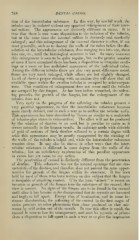Page 758 - My FlipBook
P. 758
768 DENTAL CARIES.
tion of tlie intertubular substance. In this way, by careful work, the
tubules may be isolated without any apparent enlargement of their inter-
nal calibre. The appearances are distinctly dilfei-ent in caries. It is
true that there is seen some disposition to the isolation of the tubules,
but at the same time the internal calibre is distinctly and markedly
enlarged ; and this enlargement of the internal diameter is often, if not
most generally, such as to destroy the walls of the tubes before the dis-
solution of the intertubular substance, thus merging two into one, three
into one, etc., until the histological structure is lost. In many instances
this enlargement is seen to be quite regular, but in the greater number
of cases I have examined there has been a disposition to irregular swell-
ings or a more or less nodulated appearance of the individual tubes.
Among the ditferent tubules there are also very great differences noted.
•Some are very much enlarged, while others are but slightly changed.
In all of these a proper staining with an aniline dye will show that all
available space within the swollen tubules is occupied by micro-organ-
isms. This condition of enlargement does not occur until the tubules
are occupied by this fungus. As has been before remarked, the soften-
ing precedes the growth of the fungus, but the enlargement of the
tubules does not.
Very early in the progress of the softening the tubules present a
very peculiar appearance, in that the intertubular substance becomes
more clearly defined, and in such a way as to outline the tubular walls.
This appearance has been described by Tomes as similar to a multitude
of tobacco-pipe stems in cross-section. The effect Avill not be produced
by the solution of dentine in an acid, but is peculiar to caries as it
occurs naturally in the human mouth. In stainings made with chloride
of gold of sections of fresh dentine softened to a certain degree with
acids this appearance may be greatly exaggerated by the staining of
the walls of the tubules a bright red, while the intertubular substance
remains clear. It may also be shown in other ways that the inter-
tubular substance is different in some degree from the walls of the
tubules ; but no satisfactory explanation of this peculiar appearance
in caries has yet come to my notice.
The penetration of enamel is distinctly different from the penetration
of dentine. This substance has not the natural openings that are cha-
racteristic of the dentine, and therefore does not present the same oppor-
tunities for growth of the fungus within its structure. It has been
held by most of those who have written on this subject that the fungus
is incapable of attacking enamel. If by the term '^ attack " is meant an
invasion or growth of the fungus into the substance of the enamel, this
view is correct. No signs of the fungus are to be found in the enamel
until after it has become so far disorganized that its crystals are loosened
and begin to fall apart. Except that of localization, and in some in-
stances discoloration, the softening of the enamel in the first stages of
caries presents no other phenomena than those produced on that sub-
stance by acid action out of the mouth. In case this effect is rapid, the
^namel is seen to lose its transparency, and soon its crystals or prisms
show a disposition to fall apart in such a way as to give the impression


